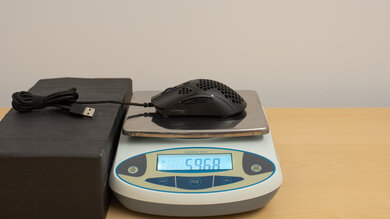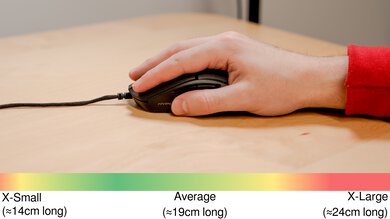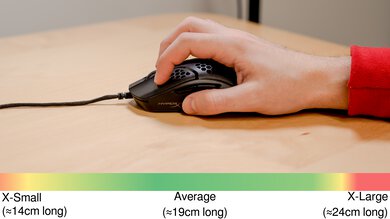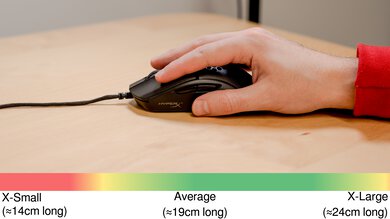The HyperX Pulsefire Haste is an excellent gaming mouse with a honeycomb body that makes it very lightweight. It feels well-built and durable and has a comfortable design that's suitable for most hand sizes using any grip style. It also comes with extra grip tape for those who want a better hold. It has remarkable feet that provide a smooth gliding experience. It also has very good click latency and a wide CPI range that’s pretty consistent, although you can’t adjust it super precisely. Unfortunately, it doesn’t have as many programmable inputs as other gaming mice, but it should still be adequate for most people. Also, the software doesn’t offer that many customization options and isn’t compatible with macOS, but at least you can save your favorite profile on the onboard memory.
Our Verdict
The HyperX Pulsefire Haste is acceptable for office use. While it's very comfortable and feels well-built, it lacks useful office features, like a horizontal scrolling wheel or wireless connectivity. It also doesn't have that many programmable inputs, and even though the mouse works on macOS, the companion software doesn't, so you can't make any customization changes.
- Comfortable, ambidextrous design.
- Feels very well-built and solid.
- Well-suited for most hand sizes with any grip type.
- May be too bulky for some laptop cases.
- Can’t be used wirelessly.
- Software not available on macOS.
The HyperX Pulsefire Haste is an excellent FPS gaming mouse. It has a honeycomb design that makes it very lightweight, while still feeling well-built and durable. Its click latency is very good, so most gamers won't notice any delays, and it has excellent feet that provide a smooth gliding experience. Its design is quite universal, and only people with smaller hands may find it hard to use it with a fingertip grip.
- Low click latency.
- Very lightweight.
- Well-suited for most hand sizes with any grip type.
- May be too bulky for some laptop cases.
- Only six programmable inputs.
The HyperX Pulsefire Haste is a decent choice for MMO gaming. It's a very comfortable mouse that feels durable and that should fit most hand sizes using any grip type. It also has very good click latency and a wide CPI range. Unfortunately, it doesn't have nearly as many programmable buttons as dedicated MMO mice, and the onboard memory only allows you to save one profile at a time.
- Comfortable, ambidextrous design.
- Feels very well-built and solid.
- Well-suited for most hand sizes with any grip type.
- May be too bulky for some laptop cases.
- Software not available on macOS.
- Not nearly as many buttons as a dedicated MMO mouse.
- May be too bulky for some laptop cases.
Changelog
- Updated Aug 19, 2025: We've converted this review to Test Bench 1.5.1. This update removes less relevant or redundant elements, including several videos. We've also adjusted our Sensor Latency testing, resulting in minor score changes. See our full 1.5.1 changelog for details.
- Updated Jan 05, 2024: We've updated the CPI graph displayed in the Sensor Latency section of this review. Our results remain the same, but these graphs have two new columns with results from the Delay At Half Movement and Delay To End Of Movement tests.
- Updated Oct 02, 2023: We've added text to this review for the new tests added in TBU 1.5.
- Updated Oct 02, 2023: We've converted this review to Test Bench 1.5. This update adds a new Main Button test group, which provides button actuation data and switch information. We've also made minor changes to how we calculate the Office usage score. For more details, you can see our full changelog here.
Check Price
Differences Between Sizes And Variants
There are no other variants of the HyperX Pulsefire Haste, and it only comes in black. You can see our unit's label here.
Popular Mouse Comparisons
The HyperX Pulsefire Haste is an excellent ultra-light gaming mouse and is among the lightest ones we’ve tested. Compared to other gaming mice, it has an almost universal design that fits most hand sizes using any grip style; only people with smaller hands using a fingertip grip may have a harder time reaching all the buttons. It also comes with extra grip tape to customize the L/R clicks and the sides to your liking. Unfortunately, it doesn’t have as many programmable inputs as other mice we’ve tested, and the L/R click buttons can only be reprogrammed as each other. For more options, check out our recommendations for the best mice, the best wired mice, and the best gaming mice.
The Logitech G PRO X SUPERLIGHT and the HyperX Pulsefire Haste are excellent ultra-light gaming mice with symmetrical shapes, but the Logitech has better overall performance. The Logitech connects wirelessly with its USB receiver. Its feet glide more smoothly on mousepads and desks, it has lower click latency, and it has a wider CPI range. Its software is also compatible with Windows and macOS. On the other hand, the HyperX is a wired-only model. It also has RGB lighting, which the Logitech lacks. However, its software is only compatible with Windows.
The GLORIOUS Model O and the HyperX Pulsefire Haste perform quite similarly. Both options are wired-only and feature a honeycomb design, but the HyperX is shorter and a bit lighter. It also has a wider CPI range and slightly better click latency, though the difference shouldn’t be noticeable. On the other hand, the GLORIOUS' cable is a little more flexible, and its set CPI is slightly more consistent. It also allows you to save more than one profile to its onboard memory.
The HyperX Pulsefire Haste 2 and the HyperX Pulsefire Haste are lightweight gaming mice in the same lineup. The newer Haste 2 has a solid plastic shell and is more lightweight. It has lower click latency, significantly better sensor performance, and it supports a higher maximum polling rate of 8000Hz. On the other hand, the older Haste feels a bit sturdier, but it's also heavier and has small honeycomb-shaped cutouts on its body.
The Razer Viper Mini and the HyperX Pulsefire Haste are both excellent ultra-light gaming mice. The HyperX features a honeycomb design, while the Razer has a plain body, but both are very light and weigh almost the same. The Razer has many more programmable inputs, as it allows you to cycle through different profiles directly on the mouse. It also has a much lower click latency. On the other hand, the HyperX is slightly more comfortable and is suitable for a lot more hand sizes and grip types, especially if you have larger hands. It also has a lower lift-off distance and a wider CPI range with a lot less variation.
Test Results

This mouse feels very well-built and solid, even if it's entirely made out of plastic and has honeycomb-patterned holes. There aren't any loose parts or squeaking sounds, and the wheel doesn't wobble. However, pinching the top and bottom parts of the mouse can cause the CPI button to activate, though this shouldn't be an issue with normal use.
The HyperX Pulsefire Haste feels very comfortable. While it only has buttons on the left side, there's no thumb rest and it has a symmetrical, ambidextrous design. There aren't any grips on the mouse itself, but it comes with grip tape that you can add on the L/R click buttons and both sides. The mouse can be used with pretty much any grip style for most hand sizes, except for smaller hands with a fingertip grip.
The HyperX Pulsefire Haste has an excellent paracord-like cable, though it retains slight kinks from the packaging.
The feet on the HyperX Pulsefire Haste are remarkable. The four rounded pads offer a smooth gliding experience. Some extra feet are included, but we couldn't find any third-party replacements at this time. If you find some, please let us know in the discussions.
This mouse's left- and right-click buttons use TTC Gold mechanical switches. Note that on the Tactile Force and Displacement Graph, there isn't any actuation data for the four cm measurement from the front of the mouse button. This data is missing because our force testing machine was unable to provide an accurate reading, as it takes an unusually high amount of force to actuate the button at this distance.
You can still actuate the main button with your finger placed four cm from the front of the button, but it requires significantly more force than it does to actuate the button with your finger placed closer to the front. Additionally, it's uncomfortable to actuate the button this far back from the front because there are honeycomb cutouts in this area.
The HyperX Pulsefire Haste has a total of six buttons, but unfortunately, you can't reprogram the up/down scroll. Also, the L/R click buttons can only be reprogrammed as each other, so you can invert the clicks for both right or left-handed use but you can't assign them any other function.
The HyperX Pulsefire Haste has very good click latency. It's suitable for playing games in any genre and it's extremely unlikely you'll notice any delays during gameplay.
The HyperX Pulsefire Haste has a wide CPI range adjustable by steps of 100, which isn't as precise as some other gaming mice we've tested. The set CPI is quite consistent whether you're moving your mouse slowly or quickly. The lift-off distance is low enough that the sensor shouldn’t track your movements when you're repositioning your mouse, and you can choose between four polling rates: 125Hz, 250Hz, 500Hz, and 1000Hz.
This mouse is loud, but it still shouldn't bother people around you unless you're in a very quiet environment.
The HyperX NGenuity software is great overall. It doesn't offer that many customization options but still allows you to adjust the RGB, CPI, and polling rate. It's only compatible with Windows, and while the mouse has onboard memory, you can only save one profile on it.












